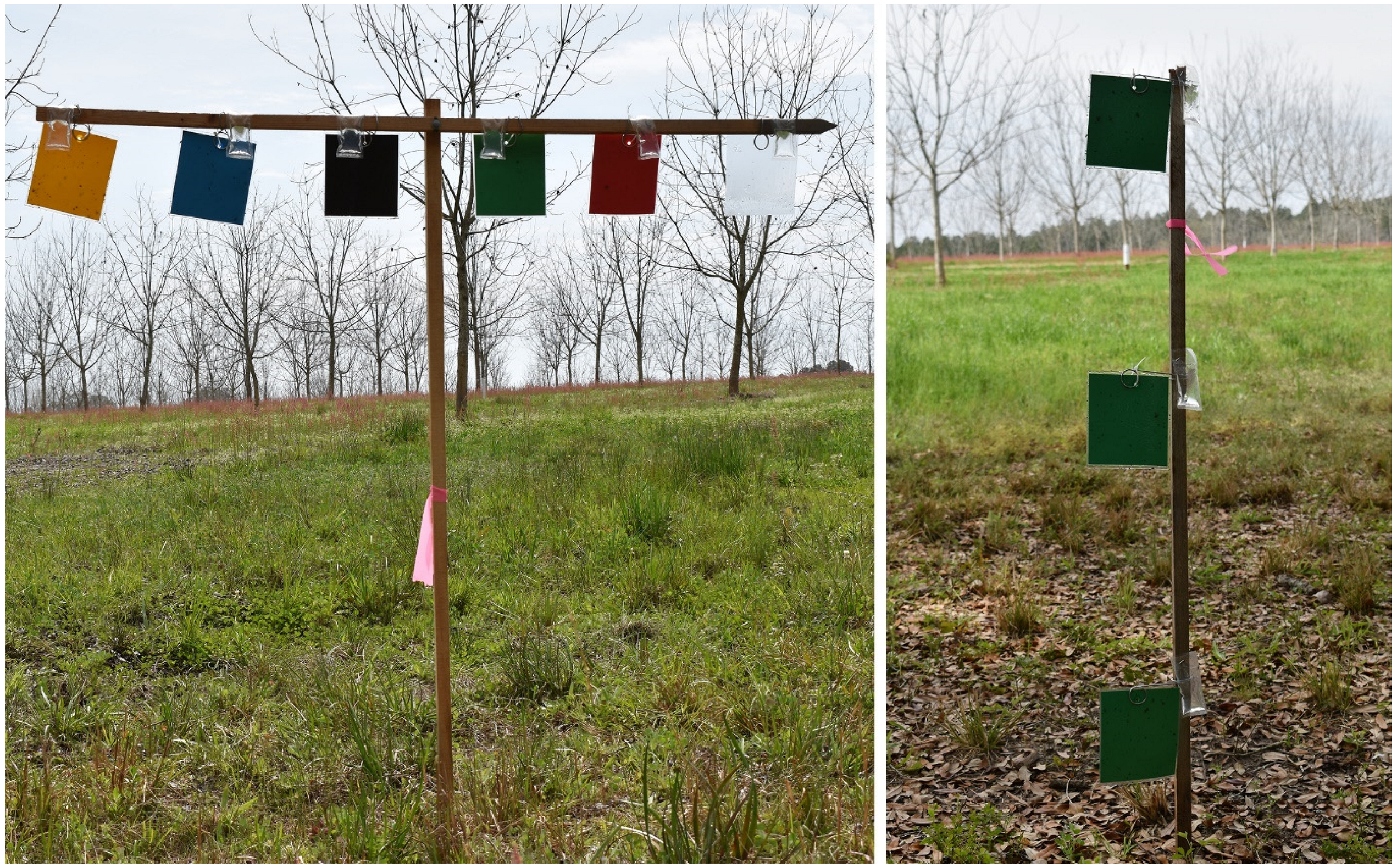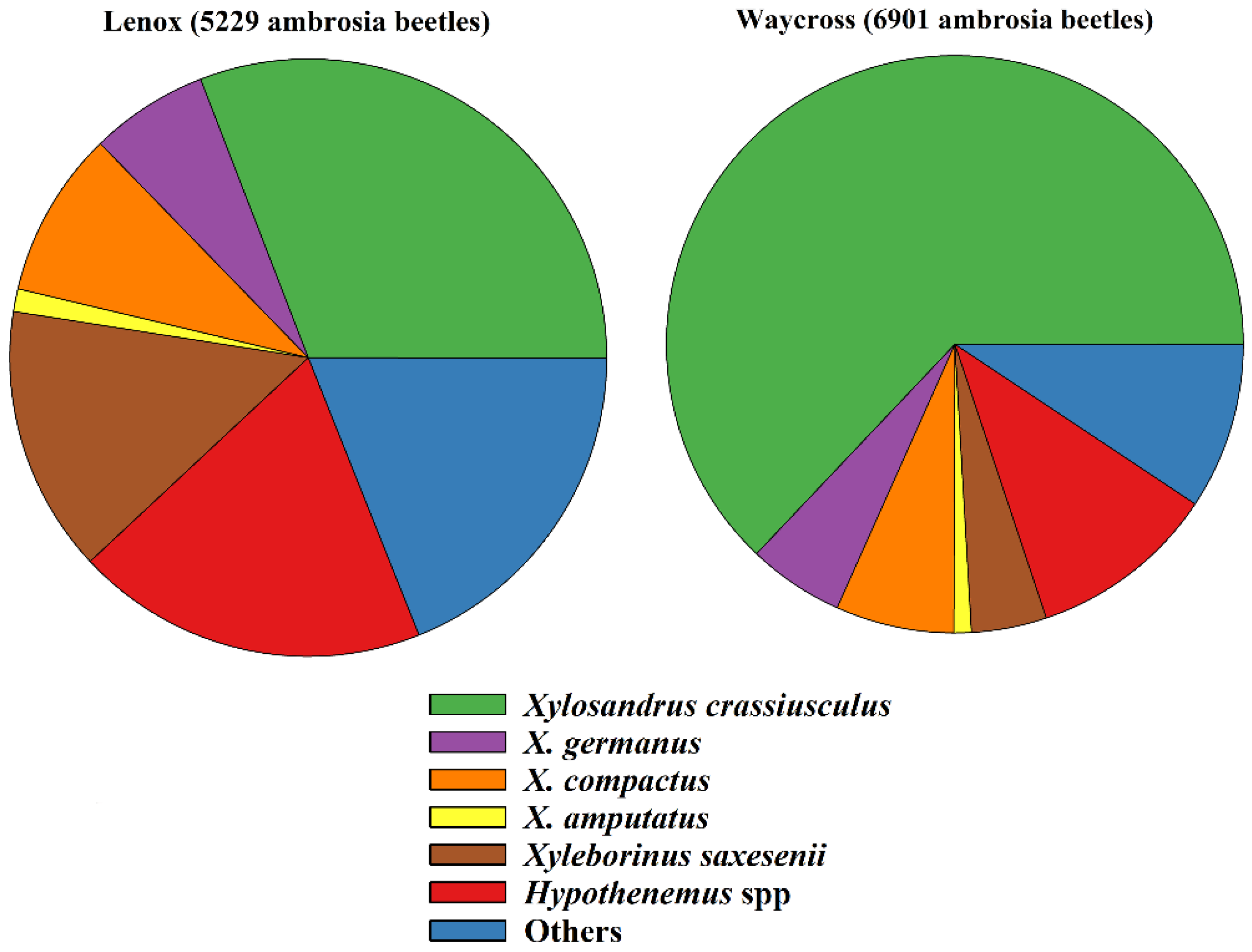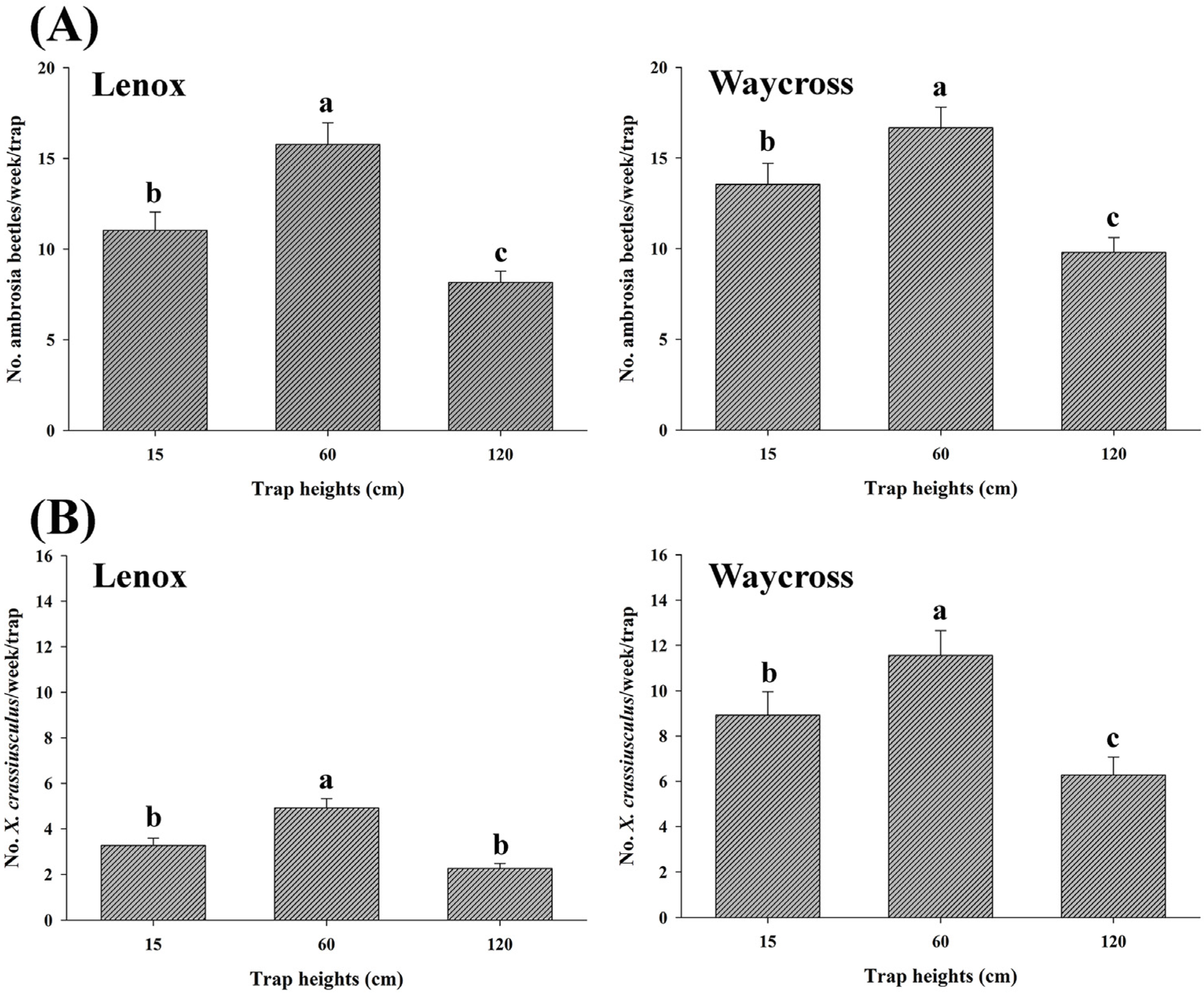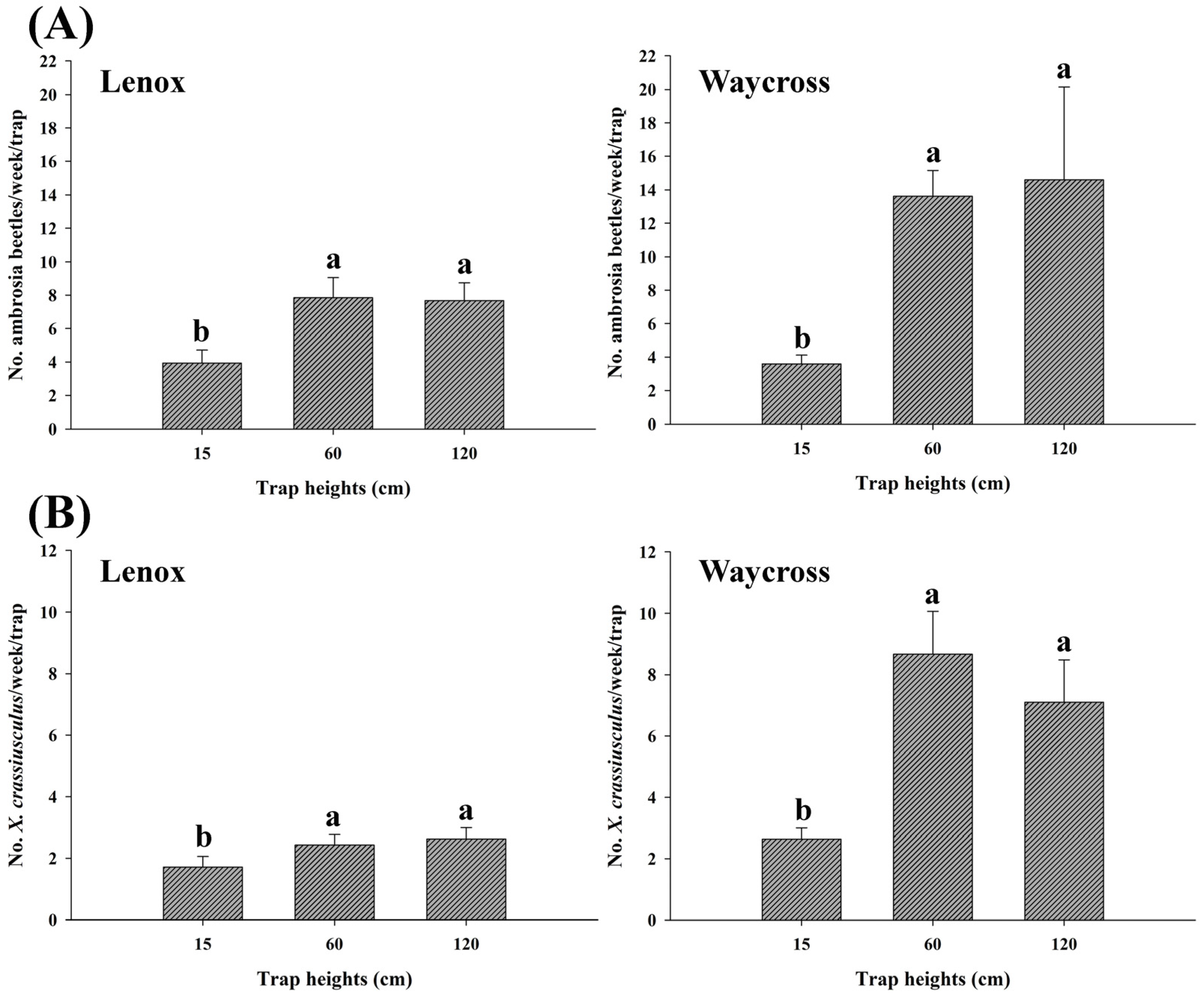Effects of Trap Color and Placement Height on the Capture of Ambrosia Beetles in Pecan Orchards
Simple Summary
Abstract
1. Introduction
2. Materials and Methods
2.1. Study Sites
2.2. Sticky Traps
2.3. Monitoring of Natural Infestations of Ambrosia Beetles
2.4. Field Experiment 1: Color Choice Experiment
2.5. Field Experiment 2: Height Choice Experiment
2.6. Lab Experiment: Color Choice Assay
2.7. Statistical Analysis
3. Results
3.1. Monitoring of Natural Infestation of Ambrosia Beetles
3.2. Ambrosia Beetle Diversity in the Pecan Orchards
3.3. Color Preference of Ambrosia Beetles
3.4. Height Preference of Ambrosia Beetles
3.5. Laboratory Based Color Preference of Xylosandrus crassiusculus
4. Discussion
5. Conclusions
Supplementary Materials
Author Contributions
Funding
Data Availability Statement
Acknowledgments
Conflicts of Interest
References
- United States Department of Agriculture National Agricultural Statistics Service (USDA-NASS). Pecan Production. 2024. Available online: https://downloads.usda.library.cornell.edu/usda-esmis/files/5425kg32f/nv936p236/00001m546/pecnpr24.pdf (accessed on 16 December 2024).
- Wang, X.; Kubenka, K.; Hilton, A.; Chatwin, W.; Cox, T.; Tondre, B. The effects of freezing and stratification on pecan (Carya illinoinensis) seed germination and seedling growth. Technol. Hortic. 2025, 5, 1. [Google Scholar] [CrossRef]
- Henin, J.M.; Versteirt, V. Abundance and distribution of Xylosandrus germanus (Blandford 1894) (Coleoptera, Scolytidae) in Belgium: New observations and an attempt to outline its range. J. Pest Sci. 2004, 77, 57–63. [Google Scholar] [CrossRef]
- Ranger, C.M.; Schultz, P.B.; Frank, S.D.; Chong, J.H.; Reding, M.E. Non-native ambrosia beetles as opportunistic exploiters of living but weakened trees. PLoS ONE 2015, 10, e0131496. [Google Scholar] [CrossRef] [PubMed]
- Acebes-Doria, A. Insect Update: Ambrosia Beetles. UGA Pecan Extension. 2019. Available online: https://site.extension.uga.edu/pecan/2019/01/insect-update-ambrosia-beetles/ (accessed on 5 February 2025).
- Ranger, C.M.; Reding, M.E.; Addesso, K.; Ginzel, M.; Rassati, D. Semiochemical-mediated host selection by Xylosandrus spp. ambrosia beetles (Coleoptera: Curculionidae) attacking horticultural tree crops: A review of basic and applied science. Can. Entomol. 2021, 153, 103–120. [Google Scholar] [CrossRef]
- Monterrosa, A.; Joseph, S.V.; Blaauw, B.; Hudson, W.; Acebes-Doria, A.L. Ambrosia beetle occurrence and phenology of Xylosandrus spp. (Coleoptera: Curculionidae: Scolytinae) in ornamental nurseries, tree fruit, and pecan orchards in Georgia. Environ. Entomol. 2022, 51, 998–1009. [Google Scholar] [CrossRef]
- Cambronero-Heinrichs, J.C.; Santoiemma, G.; Battisti, A.; Cavaletto, G.; Meggio, F.; Ranger, C.M.; Scabbio, E.; Rassati, D. Simulated flood-stress and X-ray tomography unveil susceptibility of different tree taxa to ambrosia beetles. For. Ecol. Manag. 2024, 568, 122106. [Google Scholar] [CrossRef]
- Ranger, C.M.; Reding, M.E.; Schultz, P.B.; Oliver, J.B.; Frank, S.D.; Addesso, K.M.; Chong, J.H.; Sampson, B.; Werle, C.; Gill, S.; et al. Biology, ecology, and management of nonnative ambrosia beetles (Coleoptera: Curculionidae: Scolytinae) in ornamental plant nurseries. J. Integr. Pest Manag. 2016, 7, 9. [Google Scholar] [CrossRef]
- Rassati, D.; Faccoli, M.; Haack, R.A.; Rabaglia, R.J.; Petrucco Toffolo, E.; Battisti, A.; Marini, L. Bark and ambrosia beetles show different invasion patterns in the USA. PLoS ONE 2016, 11, e0158519. [Google Scholar] [CrossRef]
- Gugliuzzo, A.; Biedermann, P.H.; Carrillo, D.; Castrillo, L.A.; Egonyu, J.P.; Gallego, D.; Haddi, K.; Hulcr, J.; Jactel, H.; Kajimura, H.; et al. Recent advances toward the sustainable management of invasive Xylosandrus ambrosia beetles. J. Pest Sci. 2021, 94, 615–637. [Google Scholar] [CrossRef]
- Monterrosa, A.; Acebes, A.L.; Blaauw, B.; Joseph, S.V. Effects of trap and ethanol lure type and age on attraction of ambrosia beetles (Coleoptera: Curculionidae). J. Econ. Entomol. 2021, 114, 1647–1654. [Google Scholar] [CrossRef]
- Felt, E.P. A new pest in greenhouse grown grape stems. J. Econ. Entomol. 1932, 25, 2. [Google Scholar]
- Dute, R.R.; Miller, M.E.; Davis, M.A.; Woods, F.M.; McLean, K.S. Effects of ambrosia beetle attack on Cercis canadensis. IAWA J. 2002, 23, 143–160. [Google Scholar] [CrossRef]
- Addesso, K.M.; Oliver, J.B.; Youssef, N.; O’Neal, P.A.; Ranger, C.M.; Reding, M.; Schultz, P.B.; Werle, C.T. Trap tree and interception trap techniques for management of ambrosia beetles (Coleoptera: Curculionidae: Scolytinae) in nursery production. J. Econ. Entomol. 2019, 112, 753–762. [Google Scholar] [CrossRef] [PubMed]
- Hulcr, J.; Stelinski, L.L. The ambrosia symbiosis: From evolutionary ecology to practical management. Annu. Rev. Entomol. 2017, 62, 285–303. [Google Scholar] [CrossRef]
- Brockerhoff, E.G.; Liebhold, A.M. Ecology of forest insect invasions. Biol. Invasions 2017, 19, 3141–3159. [Google Scholar] [CrossRef]
- Ranger, C.M.; Werle, C.T.; Schultz, P.B.; Addesso, K.M.; Oliver, J.B.; Reding, M.E. Long-lasting insecticide netting for protecting tree stems from attack by ambrosia beetles (Coleoptera: Curculionidae: Scolytinae). Insects 2019, 11, 8. [Google Scholar] [CrossRef]
- Ranger, C.M.; Tobin, P.C.; Reding, M.E. Ubiquitous volatile compound facilitates efficient host location by a non-native ambrosia beetle. Biol. Invasions 2015, 17, 675–686. [Google Scholar] [CrossRef]
- Ranger, C.M.; Gorzlancyk, A.M.; Addesso, K.M.; Oliver, J.B.; Reding, M.E.; Schultz, P.B.; Held, D.W. Conophthorin enhances the electroantennogram and field behavioural response of Xylosandrus germanus (Coleoptera: Curculionidae) to ethanol. Agric. For. Entomol. 2014, 16, 327–334. [Google Scholar] [CrossRef]
- Tobin, K.N.; Lizarraga, S.; Acharya, R.; Barman, A.K.; Short, B.D.; Acebes-Doria, A.L.; Rivera, M.J. Comparison of ethanol-baited trap designs for ambrosia beetles in orchards in the eastern United States. J. Econ. Entomol. 2024, 117, 1476–1484. [Google Scholar] [CrossRef]
- Mathieu, F.; Brun, L.O.; Marchillaud, C.; Frérot, B. Trapping of the coffee berry borer Hypothenemus hampei Ferr. (Col., Scolytidae) within a mesh-enclosed environment: Interaction of olfactory and visual stimuli. J. Appl. Entomol. 1997, 121, 181–186. [Google Scholar] [CrossRef]
- Mayfield, A.E.; Brownie, C. The redbay ambrosia beetle (Coleoptera: Curculionidae: Scolytinae) uses stem silhouette diameter as a visual host-finding cue. Environ. Entomol. 2013, 42, 743–750. [Google Scholar] [CrossRef]
- Govindaraju, R.; Joseph, S.V. Effects of purple and green-colored bottle traps on captures of ambrosia beetles in ornamental nurseries. Agronomy 2025, 15, 105. [Google Scholar] [CrossRef]
- Cavaletto, G.; Faccoli, M.; Marini, L.; Spaethe, J.; Magnani, G.; Rassati, D. Effect of trap color on captures of bark-and wood-boring beetles (Coleoptera; Buprestidae and Scolytinae) and associated predators. Insects 2020, 11, 749. [Google Scholar] [CrossRef]
- Miller, D.R. Relative effects of black, purple, and green multiple-funnel traps on catches of arboreal and saproxylic beetles in forest understoreys. Can. Entomol. 2025, 157, e6. [Google Scholar] [CrossRef]
- Werle, C.T.; Bray, A.M.; Oliver, J.B.; Blythe, E.K.; Sampson, B.J. Ambrosia beetle (Coleoptera: Curculionidae: Scolytinae) captures using colored traps in southeast Tennessee and south Mississippi. J. Entomol. Sci. 2014, 49, 373–382. [Google Scholar] [CrossRef]
- Hanula, J.L.; Ulyshen, M.D.; Horn, S. Effect of trap type, trap position, time of year, and beetle density on captures of the redbay ambrosia beetle (Coleoptera: Curculionidae: Scolytinae). J. Econ. Entomol. 2011, 104, 501–508. [Google Scholar] [CrossRef]
- Brar, G.S.; Capinera, J.L.; McLean, S.; Kendra, P.E.; Ploetz, R.C.; Peña, J.E. Effect of trap size, trap height and age of lure on sampling Xyleborus glabratus (Coleoptera: Curculionidae: Scolytinae), and its flight periodicity and seasonality. Fla. Entomol. 2012, 95, 1003–1011. [Google Scholar] [CrossRef]
- Reding, M.; Oliver, J.; Schultz, P.; Ranger, C. Monitoring flight activity of ambrosia beetles in ornamental nurseries with ethanol-baited traps: Influence of trap height on captures. J. Environ. Hortic. 2010, 28, 85–90. [Google Scholar] [CrossRef]
- Ulyshen, M.D.; Sheehan, T.N. Trap height considerations for detecting two economically important forest beetle guilds in southeastern US forests. J. Pest Sci. 2019, 92, 253–265. [Google Scholar] [CrossRef]
- Sheehan, T.N.; Ulyshen, M.D.; Horn, S.; Hoebeke, E.R. Vertical and horizontal distribution of bark and woodboring beetles by feeding guild: Is there an optimal trap location for detection? J. Pest Sci. 2019, 92, 327–341. [Google Scholar] [CrossRef]
- Klingeman, W.E.; Bray, A.M.; Oliver, J.B.; Ranger, C.M.; Palmquist, D.E. Trap style, bait, and height deployments in black walnut tree canopies help inform monitoring strategies for bark and ambrosia beetles (Coleoptera: Curculionidae: Scolytinae). Environ. Entomol. 2017, 46, 1120–1129. [Google Scholar] [CrossRef]
- Miller, D.R.; Crowe, C.M.; Sweeney, J.D. Trap height affects catches of bark and woodboring beetles (Coleoptera: Curculionidae, Cerambycidae) in baited multiple-funnel traps in Southeastern United States. J. Econ. Entomol. 2020, 113, 273–280. [Google Scholar] [CrossRef]
- Marchioro, M.; Rassati, D.; Faccoli, M.; Van Rooyen, K.; Kostanowicz, C.; Webster, V.; Mayo, P.; Sweeney, J. Maximizing bark and ambrosia beetle (Coleoptera: Curculionidae) catches in trapping surveys for longhorn and jewel beetles. J. Econ. Entomol. 2020, 113, 2745–2757. [Google Scholar] [CrossRef]
- Baker, J.R.; LaBonte, J.; Atkinson, T.H.; Bambara, S. An Identification Tool for Bark Beetles for the Southeastern United States. 2009. Available online: https://keys.lucidcentral.org/keys/v3/bark_beetles/whole_site_media/Beetle%20Key%20home.htm (accessed on 18 April 2025).
- Bateman, C.; Hulcr, J. A Guide to Florida’s Common Bark and Ambrosia Beetles. IFAS Extension and University of Florida, FOR321, 2017; pp. 1–32. Available online: https://edis.ifas.ufl.edu/publication/FR389 (accessed on 18 April 2025).
- Smith, S.M.; Beaver, R.A.; Cognato, A.I.; Hulcr, J.; Redford, A.J. Southeast Asian Ambrosia Beetle ID; USDA APHIS Identification Technology Program (ITP) and Michigan State University: Fort Collins, CO, USA, 2019. [Google Scholar]
- Bates, D.; Mächler, M.; Bolker, B.; Walker, S. Fitting linear mixed-effects models using lme4. J. Stat. Softw. 2015, 67, 1–48. [Google Scholar] [CrossRef]
- Lenth, R.V. emmeans: Estimated Marginal Means, aka Least-Squares Means; R Package, Version 1.7.3. 2022. Available online: https://CRAN.R-project.org/package=emmeans (accessed on 5 February 2025).
- R Core Team. R: A Language and Environment for Statistical Computing; R Foundation for Statistical Computing: Vienna, Austria, 2024. [Google Scholar]
- Brooks, M.E.; Kristensen, K.; van Benthem, K.J.; Magnusson, A.; Berg, C.W.; Nielsen, A.; Skaug, H.J.; Mächler, M.; Bolker, B.M. glmmTMB balances speed and flexibility among packages for zero-inflated generalized linear mixed modeling. R J. 2017, 9, 378–400. [Google Scholar] [CrossRef]
- Steininger, M.S.; Hulcr, J.; Šigut, M.; Lucky, A. Simple and efficient trap for bark and ambrosia beetles (Coleoptera: Curculionidae) to facilitate invasive species monitoring and citizen involvement. J. Econ. Entomol. 2015, 108, 1115–1123. [Google Scholar] [CrossRef]
- Reding, M.E.; Schultz, P.B.; Ranger, C.M.; Oliver, J.B. Optimizing ethanol-baited traps for monitoring damaging ambrosia beetles (Coleoptera: Curculionidae, Scolytinae) in ornamental nurseries. J. Econ. Entomol. 2011, 104, 2017–2024. [Google Scholar] [CrossRef] [PubMed]
- Abbasi, Q.D.; Jan, N.D.; Mahar, A.N.; Khuhro, R.D.; Nizamani, S.M.; Panhwar, A. Monitoring of ambrosia bark beetle through installation of sticky color traps at different heights in mango trees. Int. J. Fruit Sci. 2008, 7, 65–79. [Google Scholar] [CrossRef]
- Campbell, S.A.; Borden, J.H. Additive and synergistic integration of multimodal cues of both hosts and non-hosts during host selection by woodboring insects. Oikos 2009, 118, 553–563. [Google Scholar] [CrossRef]
- Milosavljević, I.; Hoddle, C.D.; Mafra-Neto, A.; Gómez-Marco, F.; Hoddle, M.S. Effects of food bait and trap type on captures of Rhynchophorus palmarum (Coleoptera: Curculionidae) and trap bycatch in southern California. J. Econ. Entomol. 2020, 113, 2407–2417. [Google Scholar] [CrossRef]










Disclaimer/Publisher’s Note: The statements, opinions and data contained in all publications are solely those of the individual author(s) and contributor(s) and not of MDPI and/or the editor(s). MDPI and/or the editor(s) disclaim responsibility for any injury to people or property resulting from any ideas, methods, instructions or products referred to in the content. |
© 2025 by the authors. Licensee MDPI, Basel, Switzerland. This article is an open access article distributed under the terms and conditions of the Creative Commons Attribution (CC BY) license (https://creativecommons.org/licenses/by/4.0/).
Share and Cite
Acharya, R.; Veerlapati, S.; Koirala, M.; Sawyer, A.; Barman, A.K. Effects of Trap Color and Placement Height on the Capture of Ambrosia Beetles in Pecan Orchards. Insects 2025, 16, 569. https://doi.org/10.3390/insects16060569
Acharya R, Veerlapati S, Koirala M, Sawyer A, Barman AK. Effects of Trap Color and Placement Height on the Capture of Ambrosia Beetles in Pecan Orchards. Insects. 2025; 16(6):569. https://doi.org/10.3390/insects16060569
Chicago/Turabian StyleAcharya, Rajendra, Shivakumar Veerlapati, Madhav Koirala, Andrew Sawyer, and Apurba K. Barman. 2025. "Effects of Trap Color and Placement Height on the Capture of Ambrosia Beetles in Pecan Orchards" Insects 16, no. 6: 569. https://doi.org/10.3390/insects16060569
APA StyleAcharya, R., Veerlapati, S., Koirala, M., Sawyer, A., & Barman, A. K. (2025). Effects of Trap Color and Placement Height on the Capture of Ambrosia Beetles in Pecan Orchards. Insects, 16(6), 569. https://doi.org/10.3390/insects16060569








